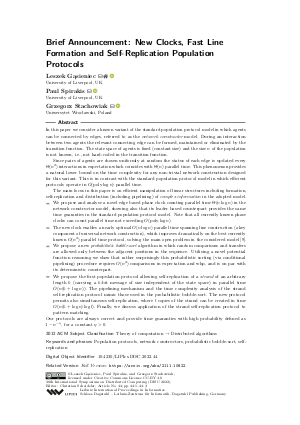Brief Announcement: New Clocks, Fast Line Formation and Self-Replication Population Protocols
Authors
Leszek Gąsieniec  ,
Paul Spirakis
,
Paul Spirakis  ,
Grzegorz Stachowiak
,
Grzegorz Stachowiak 
-
Part of:
Volume:
36th International Symposium on Distributed Computing (DISC 2022)
Part of: Series: Leibniz International Proceedings in Informatics (LIPIcs)
Part of: Conference: International Symposium on Distributed Computing (DISC) - License:
 Creative Commons Attribution 4.0 International license
Creative Commons Attribution 4.0 International license
- Publication Date: 2022-10-17
File

PDF
LIPIcs.DISC.2022.44.pdf
- Filesize: 493 kB
- 3 pages
Document Identifiers
Related Versions
- Full Version https://arxiv.org/abs/2111.10822
Subject Classification
ACM Subject Classification
- Theory of computation → Distributed algorithms
Keywords
- Population protocols
- network constructors
- probabilistic bubble-sort
- self-replication
Metrics
- Access Statistics
-
Total Accesses (updated on a weekly basis)
0Document
0Metadata
Abstract
In this paper we consider a known variant of the standard population protocol model in which agents can be connected by edges, referred to as the network constructor model. During an interaction between two agents the relevant connecting edge can be formed, maintained or eliminated by the transition function. The state space of agents is fixed (constant size) and the size n of the population is not known, i.e., not hard-coded in the transition function.
Since pairs of agents are chosen uniformly at random the status of each edge is updated every Θ(n²) interactions in expectation which coincides with Θ(n) parallel time. This phenomenon provides a natural lower bound on the time complexity for any non-trivial network construction designed for this variant. This is in contrast with the standard population protocol model in which efficient protocols operate in O(polylog n) parallel time.
The main focus in this paper is on efficient manipulation of linear structures including formation, self-replication and distribution (including pipelining) of complex information in the adopted model.
- We propose and analyse a novel edge based phase clock counting parallel time Θ(nlog n) in the network constructor model, showing also that its leader based counterpart provides the same time guaranties in the standard population protocol model. Note that all currently known phase clocks can count parallel time not exceeding O(polylog n).
- The new clock enables a nearly optimal O(nlog n) parallel time spanning line construction (a key component of universal network construction), which improves dramatically on the best currently known O(n²) parallel time protocol, solving the main open problem in the considered model [O. Michail and P. Spirakis, 2016].
- We propose a new probabilistic bubble-sort algorithm in which random comparisons and transfers are allowed only between the adjacent positions in the sequence. Utilising a novel potential function reasoning we show that rather surprisingly this probabilistic sorting (via conditional pipelining) procedure requires O(n²) comparisons in expectation and whp, and is on par with its deterministic counterpart.
- We propose the first population protocol allowing self-replication of a strand of an arbitrary length k (carrying a k-bit message of size independent of the state space) in parallel time O(n(k+log n)). The pipelining mechanism and the time complexity analysis of the strand self-replication protocol mimic those used in the probabilistic bubble-sort. The new protocol permits also simultaneous self-replication, where l copies of the strand can be created in time O(n(k+log n)log l). Finally, we discuss application of the strand self-replication protocol to pattern matching. Our protocols are always correct and provide time guaranties with high probability defined as 1-n^{-η}, for a constant η > 0.
Cite As Get BibTex
Leszek Gąsieniec, Paul Spirakis, and Grzegorz Stachowiak. Brief Announcement: New Clocks, Fast Line Formation and Self-Replication Population Protocols. In 36th International Symposium on Distributed Computing (DISC 2022). Leibniz International Proceedings in Informatics (LIPIcs), Volume 246, pp. 44:1-44:3, Schloss Dagstuhl – Leibniz-Zentrum für Informatik (2022)
https://doi.org/10.4230/LIPIcs.DISC.2022.44
BibTex
@InProceedings{gasieniec_et_al:LIPIcs.DISC.2022.44,
author = {G\k{a}sieniec, Leszek and Spirakis, Paul and Stachowiak, Grzegorz},
title = {{Brief Announcement: New Clocks, Fast Line Formation and Self-Replication Population Protocols}},
booktitle = {36th International Symposium on Distributed Computing (DISC 2022)},
pages = {44:1--44:3},
series = {Leibniz International Proceedings in Informatics (LIPIcs)},
ISBN = {978-3-95977-255-6},
ISSN = {1868-8969},
year = {2022},
volume = {246},
editor = {Scheideler, Christian},
publisher = {Schloss Dagstuhl -- Leibniz-Zentrum f{\"u}r Informatik},
address = {Dagstuhl, Germany},
URL = {https://drops.dagstuhl.de/entities/document/10.4230/LIPIcs.DISC.2022.44},
URN = {urn:nbn:de:0030-drops-172351},
doi = {10.4230/LIPIcs.DISC.2022.44},
annote = {Keywords: Population protocols, network constructors, probabilistic bubble-sort, self-replication}
}
Author Details
References
-
D. Angluin, J. Aspnes, Z. Diamadi, M.J. Fischer, and R. Peralta. Computation in networks of passively mobile finite-state sensors. In Proc. PODC 2004, pages 290-299, 2004.

-
D. Angluin, J. Aspnes, and D. Eisenstat. Fast computation by population protocols with a leader. Distributed Comput., 21(3):183-199, 2008.

- L. Gąsieniec, P.G. Spirakis, and G. Stachowiak. New clocks, optimal line formation and efficient replication population protocols (making population protocols alive). CoRR, abs/2111.10822, 2021. URL: http://arxiv.org/abs/2111.10822.
- A. Czumaj and A. Lingas. On truly parallel time in population protocols. CoRR, abs/2108.11613, 2021. URL: http://arxiv.org/abs/2108.11613.
-
D. Doty, M. Eftekhari, L. Gąsieniec, E.E. Severson, G. Stachowiak, and P. Uznański. A time and space optimal stable population protocol solving exact majority. In 62nd IEEE Annual Symposium on Foundations of Computer Science, FOCS 2021, pages 1044-1055, 2021.

-
L. Gąsieniec and G. Stachowiak. Enhanced phase clocks, population protocols, and fast space optimal leader election. J. ACM, 68(1):2:1-2:21, 2021.

-
R.A. Freitas Jr and R.C. Merkle. Kinematic Self-Replicating Machines. Landes Bioscience, Georgetown, TX, 2004.

-
T.A. Lincoln and G.F. Joyce. Self-sustained replication of an rna enzyme. In Science, Vol 323, Issue 5918, pages 1229-1232. American Association for the Advancement of Science, 2009.

-
O. Michail and P. Spirakis. Simple and efficient local codes for distributed stable network construction. Distributed Computing, 29(3):207-237, 2016.

-
E. Moulin and N. Giuseppone. Dynamic combinatorial self-replicating systems. In Constitutional Dynamic Chemistry, pages 87-105. Springer, 2011.

